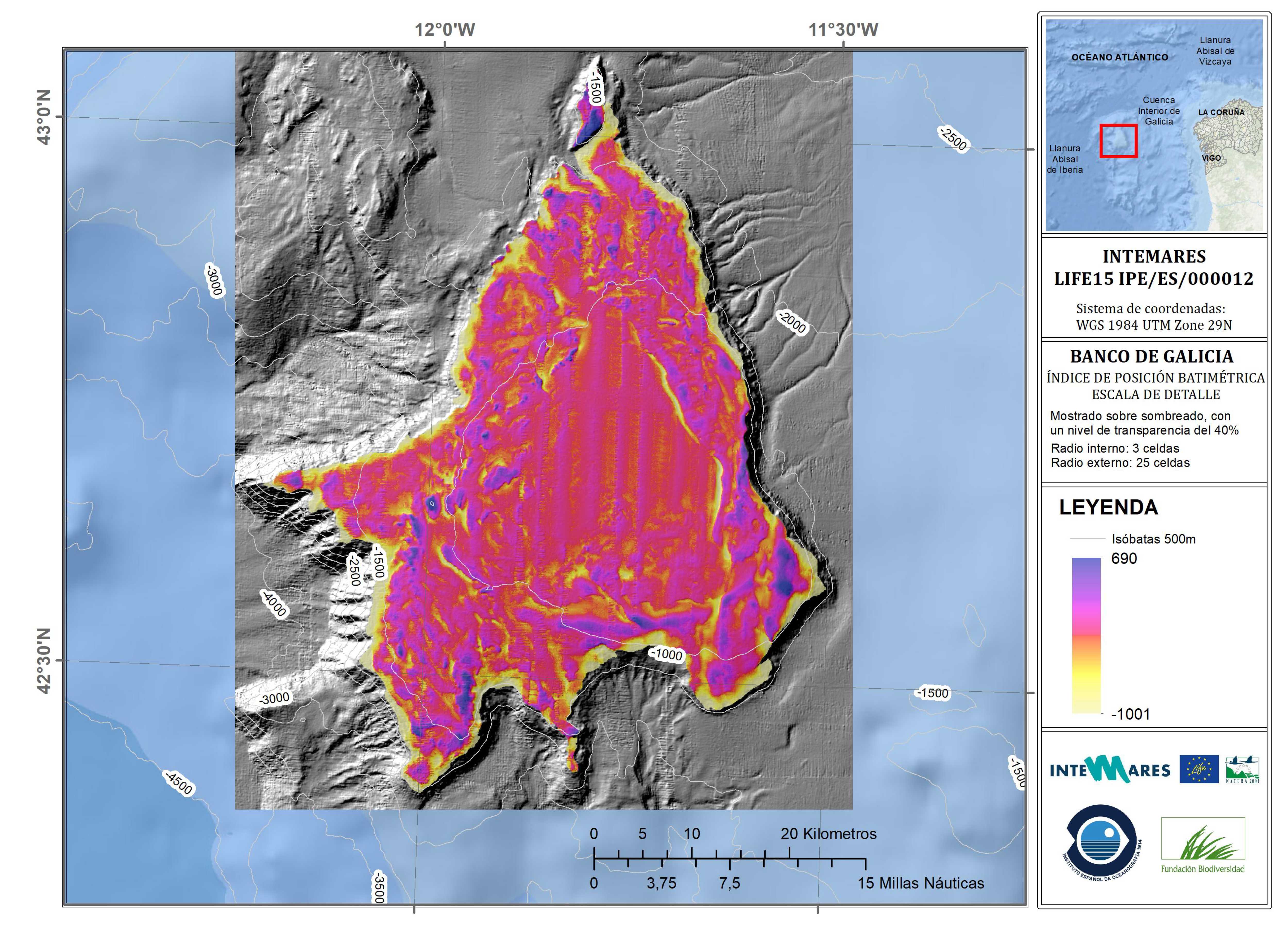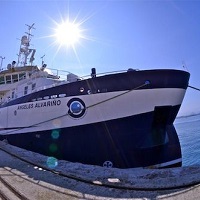Creation year
2020
115 record(s)
Type of resources
Categories
Topics
INSPIRE themes
Keywords
Contact for the resource
Provided by
Years
Formats
Status
Scale
-

La información contenida en este conjunto de datos es un ráster con el Índice de Posición Batimétrica (BPI) de escala fina de la zona de estudio, a 75 m de resolución y calculada con un radio interno de 1 celda y un radio externo de 15 celdas. La zona que comprenden los datos proporcionados abarca el LIC Banco de Galicia. Este conjunto de información se calcula en base a la batimetría original. La elaboración de este conjunto de información geográfica comenzó en 2010, gracias a la campaña oceanográfica IBANGAL0710 y BANGAL0711. En 2019 se acometió un reanálisis de dichos datos con nuevo software y nuevas técnicas y algoritmos, mejorando la resolución espacial . La información geográfica resultante se almacena en una base de datos espaciales. Los trabajos de reprocesado se han financiado gracias al Proyecto LIFE IP INTEMARES (LIFE-IP INTEMARES - Integrated, Innovative and Participatory Management for N2000 network in the Marine Environment - LIFE15 IPE/ES/000012). Este proyecto integrado tiene el reto de sentar las bases para gestionar de forma eficaz los espacios marinos de la Red Natura 2000 y completar los trabajos y avances impulsados en el marco del proyecto LIFE+ INDEMARES, que logró dar un gran paso en materia de declaración de nuevos espacios.
-

El Visor de información marina muestra información de la naturaleza del fondo, batimetría, límites de reservas, información ambiental, caladeros de pesca, arrecifes artificiales y límites administrativos, (a título informativo y sin validez legal).
-
La información contenida en este conjunto de datos corresponde a la distribución espacial de los hábitats bentónicos del Banco de Galicia. La distribución de estos hábitats se obtuvo mediante el modelado (GAM) de datos de presencia y ausencia de dichos hábitats y se unieron todos en un sólo mapa utilizando como umbral 'kappa'. La identificación y definición de cada hábitat se realizó mediante el empleo de técnicas de análisis multivariante aplicadas sobre datos obtenidos con diversas técnicas de muestreo extractivas (arrastre y dragas). En total se realizaron 19 dragas de arrastre con puertas, 29 arrastre con ‘bou de vara’ y 27 dragas de roca. Los resultados biológicos fueron integrados con la caracterización morfosedimentaria. La zona que comprenden los datos proporcionados abarca las aguas y el lecho marino del propio Banco de Galicia (Demarcación Noratlántica) y de un conjunto de montes submarinos y zonas adyacentes. Se trata de un conjunto de datos compuesto por elementos poligonales, donde cada elemento representa un hábitat bentónico. Cada objeto tiene asociada una serie de variables alfanuméricas que se corresponden con los diferentes códigos y nomenclaturas de los diferentes hábitats en las diferentes listas o catálogos internacionales y nacionales y de hábitats bentónicos. La elaboración de este conjunto de información geográfica comenzó durante el desarrollo del plan INDEMARES, gracias a las 3 campañas oceanográficas que se realizaron entre 2009 y 2011 en el marco de dicho proyecto. La información geográfica recogida se almacenan en una base de datos espaciales. Estos trabajos se han financiado gracias al Proyecto LIFE IP INTEMARES (LIFE-IP INTEMARES - Integrated, Innovative and Participatory Management for N2000 network in the Marine Environment - LIFE15 IPE/ES/000012). Este proyecto integrado tiene el reto de sentar las bases para gestionar de forma eficaz los espacios marinos de la Red Natura 2000 y completar los trabajos y avances impulsados en el marco del proyecto LIFE+ INDEMARES, que logró dar un gran paso en materia de declaración de nuevos espacios.
-

Multidisciplinary cruise: Sampling physical and chemical variables that will: - Study thermohaline characteristics, kinematics, dynamics and biology of the eastern half of the Gulf of Cadiz - Establish relationships between climate, hydrology and hydrodynamics and the early stages of development of the species associated with the platform. - Provide data to feed global and regional numerical models. - Generate and distribute a database for the evolution of the marine climate and its resources.
-

Multidisciplinary cruise: Sampling physical and chemical variables that will: - Study thermohaline characteristics, kinematics, dynamics and biology of the eastern half of the Gulf of Cadiz - Establish relationships between climate, hydrology and hydrodynamics and the early stages of development of the species associated with the platform. - Provide data to feed global and regional numerical models. - Generate and distribute a database for the evolution of the marine climate and its resources.
-

Historical series of oceanographic data in the Coruña Estuary and adjacent platform.
-

This cruise continues with the line started in previous years cruises with the general operational target of the registration of oceanographic parameters and obtaining water samples and various types of suitable and sufficient plankton for the achievement of the following specific objectives: 1- Obtaining data on larval densities and CTD profiles to estimate Larval abundance indices for species of the genus Thunnus in the Balearic Sea. 2- Determine the influence of hydrographic scenario on the structure, distribution and condition of large and medium pelagic larval populations in the Balearic Sea, with special attention to Atlantic bluefin tuna. 3- Identification of the hydrographic processes that determine the productivity of the pelagic ecosystem of the Balearic Sea. 4- Characterization of the genetic structure of the larval populations of bluefin tuna and related species in the Balearic Sea, used for the 'close-kin' studies recently initiated by ICCAT. 5- Evaluate the possibility of using acoustic methods in the characterization of bluefin tuna populations and the distribution of larval habitats.
-

Historical series of oceanographic data in the Vigo Estuary and adjacent platform.
-
La información contenida en este conjunto de datos se corresponde con el LIC del Banco de La Concepción (ESZZ15001), una de las áreas de estudio del proyecto INTEMARES. El monte submarino denominado Banco de La Concepción está ubicado al norte de Lanzarote (Islas Canarias - Macaronesia - Océano Atlántico). Se trata de un solo elemento poligonal que representa la zona de la campaña INTEMARES-A 4-CANARIAS-1118. El objeto tiene asociado las variables alfanuméricas de área en distintas unidades. La información geográfica recogida se almacenan en una base de datos espaciales. En la zona se han realizado varias campañas oceanográficas. Estos trabajos se han financiado gracias al Proyecto LIFE IP INTEMARES (LIFE-IP INTEMARES - Integrated, Innovative and Participatory Management for N2000 network in the Marine Environment - LIFE15 IPE/ES/000012). Este proyecto integrado tiene el reto de sentar las bases para gestionar de forma eficaz los espacios marinos de la Red Natura 2000 y completar los trabajos y avances impulsados en el marco del proyecto LIFE+ INDEMARES, que logró dar un gran paso en materia de declaración de nuevos espacios.
-

Acoustic estimation of abundance of juvenile anchovy in the Bay of Biscay.
 Catálogo de datos del IEO
Catálogo de datos del IEO